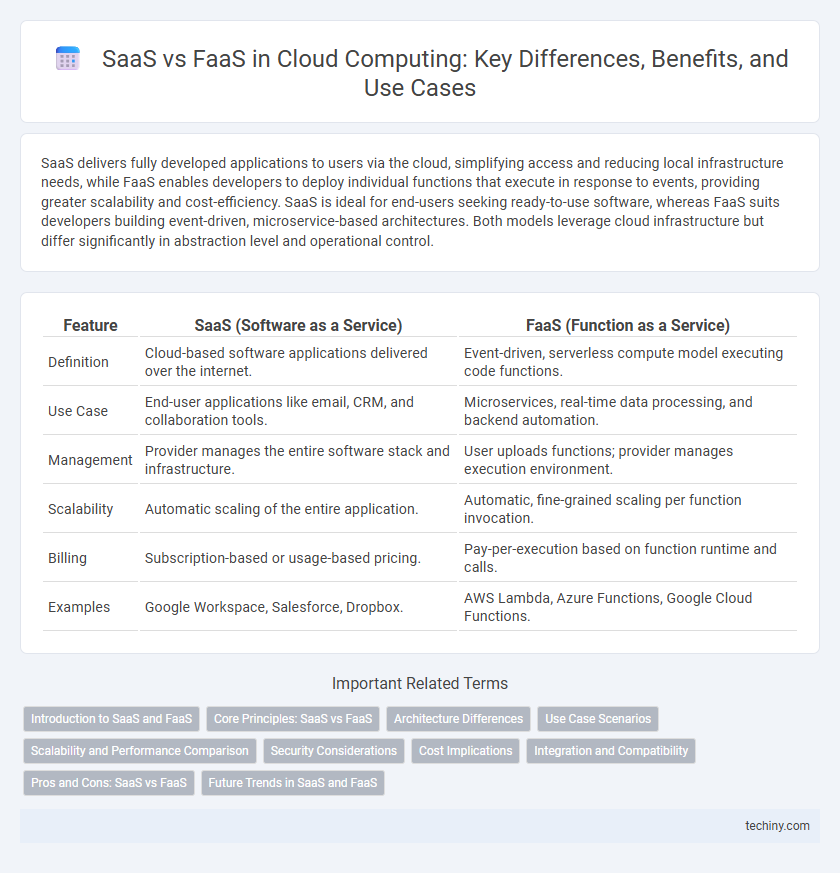SaaS delivers fully developed applications to users via the cloud, simplifying access and reducing local infrastructure needs, while FaaS enables developers to deploy individual functions that execute in response to events, providing greater scalability and cost-efficiency. SaaS is ideal for end-users seeking ready-to-use software, whereas FaaS suits developers building event-driven, microservice-based architectures. Both models leverage cloud infrastructure but differ significantly in abstraction level and operational control.
Table of Comparison
| Feature | SaaS (Software as a Service) | FaaS (Function as a Service) |
|---|---|---|
| Definition | Cloud-based software applications delivered over the internet. | Event-driven, serverless compute model executing code functions. |
| Use Case | End-user applications like email, CRM, and collaboration tools. | Microservices, real-time data processing, and backend automation. |
| Management | Provider manages the entire software stack and infrastructure. | User uploads functions; provider manages execution environment. |
| Scalability | Automatic scaling of the entire application. | Automatic, fine-grained scaling per function invocation. |
| Billing | Subscription-based or usage-based pricing. | Pay-per-execution based on function runtime and calls. |
| Examples | Google Workspace, Salesforce, Dropbox. | AWS Lambda, Azure Functions, Google Cloud Functions. |
Introduction to SaaS and FaaS
Software as a Service (SaaS) delivers cloud-based applications accessible via web browsers, eliminating the need for local installation and maintenance while ensuring scalability and automatic updates. Function as a Service (FaaS), also known as serverless computing, enables developers to deploy individual functions in response to events without managing underlying infrastructure, optimizing resource usage and cost efficiency. Both SaaS and FaaS streamline cloud adoption by offering flexible service models tailored to different operational needs and development approaches.
Core Principles: SaaS vs FaaS
SaaS (Software as a Service) delivers fully managed software applications over the internet, enabling users to access and use software without concern for underlying infrastructure or platform management. FaaS (Function as a Service) provides event-driven, serverless computing that allows developers to deploy discrete functions or code snippets, automatically scaling based on demand without provisioning servers. SaaS emphasizes end-user application accessibility, while FaaS focuses on granular, backend code execution, optimizing resource utilization and operational efficiency in cloud environments.
Architecture Differences
SaaS (Software as a Service) delivers fully managed applications over the internet, where users interact with software hosted on centralized servers, abstracting infrastructure complexities. FaaS (Function as a Service) operates at the function level, enabling developers to deploy individual event-driven functions that automatically scale and execute in response to triggers without managing server resources. SaaS architecture emphasizes user-facing applications with multi-tenancy and persistent session management, whereas FaaS relies on stateless, ephemeral functions executed within containerized environments, optimizing for agility and granular resource utilization.
Use Case Scenarios
SaaS is ideal for end-users seeking ready-to-use applications like CRM, email, or collaboration tools without managing infrastructure. FaaS excels in event-driven architectures, enabling developers to run small, stateless functions triggered by events such as file uploads or HTTP requests. Enterprises leverage SaaS for business productivity, while FaaS suits dynamic, scalable processes like data processing, real-time analytics, and microservices integration.
Scalability and Performance Comparison
SaaS platforms offer scalable application access with pre-configured resources, ideal for consistent workloads but may face performance limits under sudden spikes. FaaS architectures provide automatic scaling with granular resource allocation per function execution, enabling rapid adaptation to varying loads and improved cost efficiency. Performance in FaaS excels in event-driven, stateless tasks, whereas SaaS is better suited for sustained, user-centric applications requiring persistent state.
Security Considerations
SaaS platforms typically offer built-in security features managed by the provider, including data encryption, access controls, and regular compliance audits, reducing the burden on users. FaaS environments require rigorous security practices around function-level permissions, event trigger validation, and ephemeral data handling to prevent vulnerabilities and ensure secure execution. Understanding these security considerations is critical for organizations to safeguard sensitive information and maintain regulatory compliance when choosing between SaaS and FaaS solutions.
Cost Implications
SaaS offers predictable subscription pricing, often reducing upfront costs for businesses by eliminating the need for infrastructure management, while FaaS employs a pay-as-you-go model charging based on execution time and resource consumption, which can lead to significant savings for variable workloads. Cost implications of SaaS include ongoing fees that may escalate with user growth, whereas FaaS minimizes expenses during periods of low activity but can become costly with high-frequency function invocations. Evaluating workload patterns and scalability requirements is essential to determine whether the fixed pricing of SaaS or the event-driven cost structure of FaaS provides better economic efficiency.
Integration and Compatibility
SaaS platforms offer seamless integration with existing enterprise applications through standardized APIs and built-in connectors, ensuring broad compatibility across diverse software ecosystems. FaaS enables event-driven, granular function execution that integrates efficiently with microservices architectures and third-party services via lightweight APIs, optimizing interoperability in cloud-native environments. Both models prioritize compatibility, but SaaS emphasizes end-to-end application integration while FaaS focuses on modular, scalable function-level connectivity.
Pros and Cons: SaaS vs FaaS
SaaS (Software as a Service) offers ready-to-use applications with easy scalability and minimal management, ideal for businesses seeking quick deployment and predictable costs, but it can limit customization and integration flexibility. FaaS (Function as a Service) enables event-driven, serverless execution with granular scaling and reduced infrastructure overhead, providing cost efficiency and rapid development, yet it introduces complexity in managing distributed functions and potential latency issues. Choosing between SaaS and FaaS depends on specific use cases, with SaaS suited for standardized workflows and FaaS optimal for highly dynamic, microservice-based architectures.
Future Trends in SaaS and FaaS
Future trends in SaaS emphasize AI integration, hyperautomation, and personalized user experiences to enhance business efficiency and scalability. FaaS is evolving with improved event-driven orchestration, enhanced multi-cloud compatibility, and advanced security measures to support granular computing needs. Both models are converging towards greater flexibility, cost optimization, and seamless integration with edge computing and IoT ecosystems.
SaaS vs FaaS Infographic

 techiny.com
techiny.com